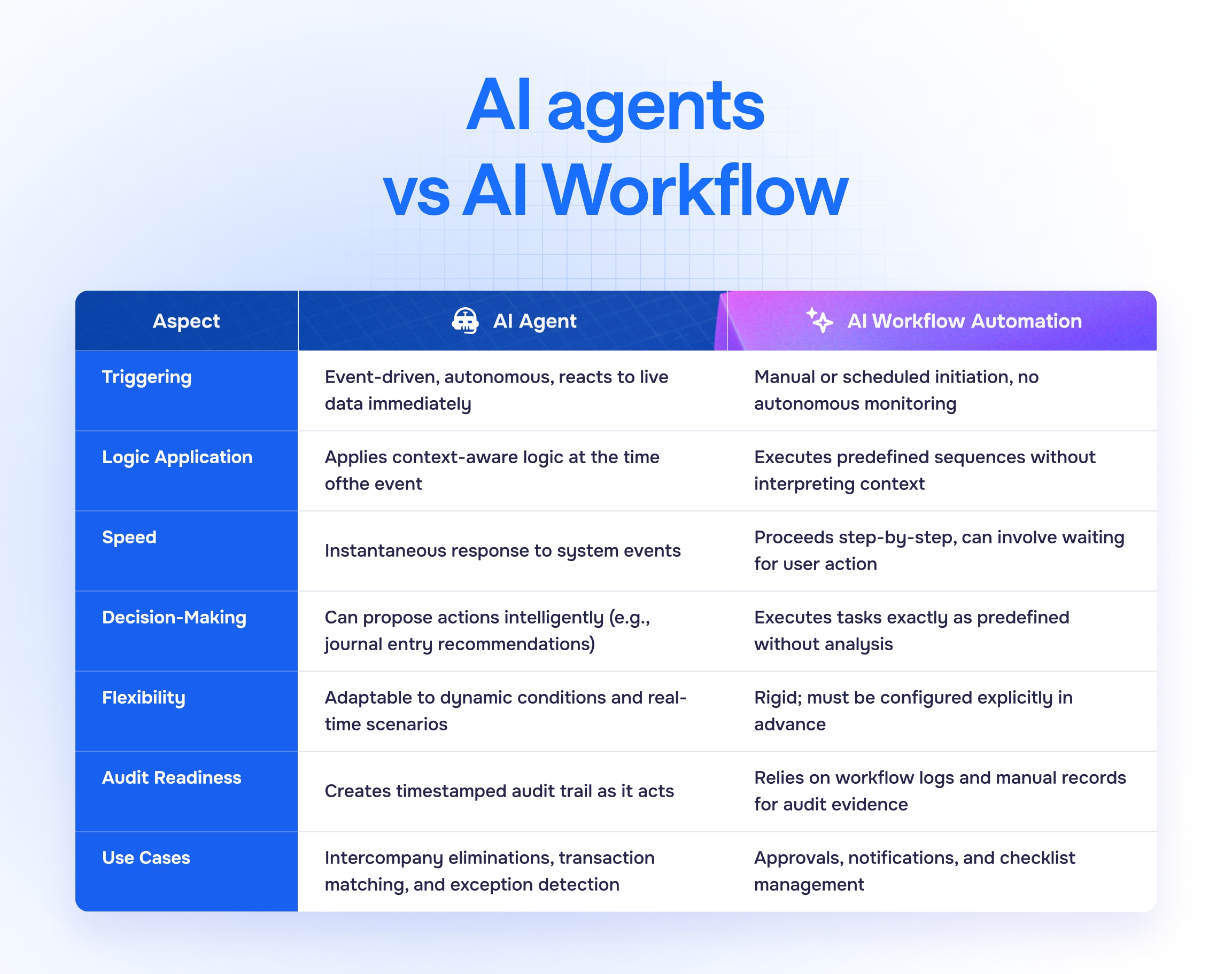
AI agent vs AI workflow captures how event-driven automation can analyze real-time financial data, apply logic immediately, improve close cycles, strengthen audit trails, and reduce manual effort across multi-entity environments.
If you’ve been exploring automation in finance, you may wonder how AI agents truly differ from workflow automation, and why this distinction matters.
At first glance, both approaches seem to offer the same promise: reducing manual effort and improving efficiency. But beneath the surface, their purpose and design are fundamentally different.
In this article, we’ll unpack the differences in AI agent vs AI workflow automation, using real accounting scenarios to illustrate their roles. We’ll also explain why their response to events, particularly their ability to trigger intelligently, is where the most significant difference lies.
What’s an AI Agent?
An AI agent is an autonomous software process that monitors a financial system for relevant events and acts immediately when conditions are met. It does not wait for schedules or human initiation but proactively evaluates data and takes meaningful action.
They can:
- Analyze financial context in real time
- Apply configurable logic written in natural language
- Generate transactions such as journal entries or eliminations
- Provide recommended outputs for review, maintaining user oversight
For instance, when a draft intercompany journal entry is created, an AI agent can identify prior matching transactions, adjust amounts and dates, and prepare a recommended elimination entry for approval. This cuts time spent reconciling data and reduces errors by leveraging contextual information automatically.
What’s AI Workflow Automation?
Workflow automation coordinates a series of predefined steps. It helps structure processes such as review chains or notifications, but typically requires manual triggers or schedules.
In finance teams, common workflows might include routing journals for approval, alerting when close checklists are complete, or enforcing segregation of duties.
Workflow automations:
- Follow rigid sequences
- Require human or scheduled initiation
- Do not interpret context or data patterns
A workflow might notify a controller when journals are ready for review, ensuring oversight but not analyzing journal content or preparing recommended eliminations.
AI Agent vs AI Workflow: Why Triggering Matters

This distinction goes beyond operations. Triggering is central to how this type of automation improves audit readiness and compliance. Acting immediately on live data ensures a timestamped audit trail and consistent application of accounting policies.
While workflows execute predefined steps on command, these automated systems detect events as they happen and apply intelligent logic in real-time. For finance teams managing multi-entity environments and fragmented systems, this reduces delays, improves consistency, and lowers risk.
The debate around AI agent vs AI workflow comes down to this: triggering allows AI agents to monitor financial data continuously and respond immediately to activity, advancing automation from task orchestration to intelligent decision making.
You might also like: How Finance Teams Use Trigger Agents
Real Examples in Finance Automation
In modern accounting operations, this automation is enabling new levels of efficiency, precision, and scalability, reinforcing the practical advantages of AI agent vs AI workflow approaches.
Intercompany Draft Matching
When a draft journal entry is created, the system searches historical transactions for matches, adjusts dates and amounts as needed, and prepopulates a recommended elimination entry. This eliminates time-consuming reconciliations and reduces errors by automatically applying relevant context.
Transaction Pairing and Validation
When a journal entry posts, the automation immediately scans for related entries, checks references and values, and proposes eliminations if appropriate. This helps maintain clean ledgers and ensures that intercompany balances are resolved efficiently.
Where This Leads
Finance teams in production environments already report measurable gains from this type of automation, including faster close cycles, reduced reconciliation workloads, and more complete audit trails.
This architecture supports a broad set of scenarios, including:
Post-Matching Eliminations
The system can reconcile and eliminate transactions automatically when matching criteria are met, reducing reconciliation effort and improving audit trail completeness.
Threshold-Driven Alerts and Postings
Automated processes flag transactions exceeding defined limits and prepopulate them for action, supporting timely financial oversight.
Vendor Bill Creation
Automation can create vendor bills directly from journal activity, reducing manual entry and improving accounts payable accuracy.
Autonomous Exception Handling
Automated technology detects anomalies in real time during close and surfaces them for review before delays occur, allowing finance teams to address issues proactively.
In every case, triggering enables these capabilities to operate continuously and intelligently, advancing automation toward autonomy while preserving transparency, auditability, and control.
Understanding the differences between AI agent vs AI workflow approaches is essential for finance leaders making informed decisions.
While workflows help structure predefined processes, AI agents deliver intelligent, event-driven automation that responds in real time to financial data, improving efficiency, audit readiness, and scalability.
Book a demo with Nominal today to see this in action and explore how event-driven finance automation can transform your operations.






